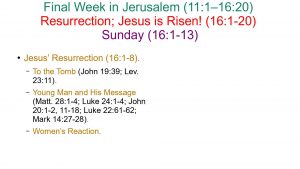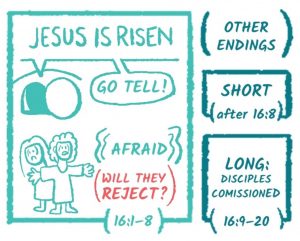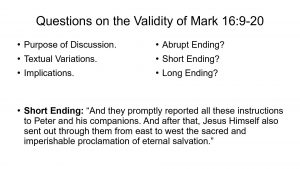Jesus’ Final Week in Jerusalem
Mark 11:1–16:20
Teaching (11:1–13:37)
King (11:1-11)
Sunday: Triumphal Entry (11:1-11).
Lawgiver (11:12–12:44)
Monday (11:12-19).
Tuesday (11:20–14:2).
Prophet (13:1-37)
Trial (14:1-72)
Sacrifice (14:1-26)
Wednesday (14:3-11).
Thursday (14:12-72)
Betrayed and Killed (14:27–15:47)
Death (15:1-47)
Friday (15:1-47).
Resurrection (16:1-20)
Jesus is Risen!
Sunday and Later (16:1-20).
Jesus’ Resurrection (16:1-8).
To the Tomb.
The Young Man and His Message.
The women hear this instruction, and they flee, afraid and amazed.
Next we will discuss the huge asterisk we see in many of our Bibles on vs. 9-20, but let’s assume for a moment that Mark meant to leave his gospel account of here in vs. 8.
It says, “they said nothing to anyone, for they were afraid.”
That implies they did not heed the angel’s instruction and kept this marvelous news to themselves.
What a way to end a gospel account! Will they tell the disciples or won’t they?
Obviously, no one could sit on this grand a revelation for too long, so it was likely that they were silent and afraid for a brief period of time before they carried out the angel’s instruction.
They likely told no one on their way to see Peter and the other disciples.
And we find in this “longer ending” that that’s exactly what happens.
 Question on Validity of the Following (16:9-20).
Question on Validity of the Following (16:9-20).Purpose of Discussion.
This is something we must absolutely discuss. Why?
Because it’s in nearly everyone of our Bibles as a footnote or something more obvious that it’s not original.
My NKJV says in its footnote: “Verses 9-20 are bracketed in NU-Text [critical text] as not original. They are lacking in Codex Sinaiticus and Codex Vaticanus, although nearly all other manuscripts of Mark contain them.”
The NIV and ESV have notes in between vss. 8 and 9, and the NIV’s reads: “The earliest manuscripts and some other ancient witnesses do not have verses 9-20.”
The NASB brackets off these verses and says in a footnote: “Later mss add vv 9-20.”
Adding verses? Not in the original? What gives? Why are they here if they don’t belong in our Bibles?
 Textual Variations—a brief word.
Textual Variations—a brief word.Before we get into this, I want to stress a few points.
No original manuscripts of the NT exist today. These are called autographs. So how can we be sure of what the NT says?
Well, the faithful made copies, then made copies of those copies, but of course, they didn’t have a Xerox machine back then, so errors crept up.
Someone made a typo, then someone who copied from them tried to correct it.
Sometimes they didn’t make an error, but the scribe thought they did, so he was making an unwarranted.
But the ironic thing is, this is actually a blessing!
You see, if you have 100 sources, and 1 of them has it worded one way, but 99 others have it some other way, which are you going to trust? The 99, of course!
And there are vastly more copies of the NT that we have today than any other ancient text, over 5000 more! 5366 by 1986 (Geisler 387).
And the vast majority of variations occur with spelling (especially that removable nu). There is more agreement with the various copies of the NT than any other ancient document by several orders of magnitude.
So would we trust one easily corruptible source, or a combination of the 5000+ sources that have been preserved for us?
We can be assured that the NT we have in our hands today is accurate, no less that 99.9%!
But what that means is that there are a scant few passages in that 0.1% that are difficult, Mark 16:9-20 being one of the most.
Implications.
First, let’s consider the implications if it doesn’t belong there.
We often cite Mark 16:16 when it comes to the necessity of baptism for salvation.
It is pretty on-point, and un-get-around-able, though that doesn’t stop people from trying.
We will also use Mark 16:20 to show the purpose of miracles, to confirm the word.
But are any of these teachings unique to Mark 16:9-20? Will the truth about baptism be undermined if we remove Mark 16:16? The purpose of miracles? No, no, and no.
The only unique thing we might find is the drinking of anything deadly (16:18).
Some skeptics will say that the truth of the resurrection is called into question, but as we’ve already read in 16:1-8, the tomb was empty.
While Jesus Himself had not yet been seen, the empty tomb and the testimony of the young man (angel) is solid, not to mention what we have recorded elsewhere in the NT.
So regardless of whether or not it belongs here, the truth remains unchanged.
For the record, I do believe it belongs here, as we’ll see.
Ending at Mark 16:8?
There are many arguments for the Gospel of Mark ending abruptly after 16:8.
As stated, it is not in certain key manuscripts that are considered to be the earliest we have, even older than what the KJV is based on.
All the commentaries have a listing of all the fragments, manuscripts, versions, and quotations that are relevant to the discussion, but it’s just a bunch of names and numbers that you probably have never heard of, so I summarize.
About 95 ancient manuscripts do not have it, including 90 Armenian manuscripts, likely from the same family.
While two prominent early theologians (Clement of Alexandria and Origen) did not quote from it, while two others (Eusebius and Jerome) specially speak against the longer ending—though it did exist.
This abrupt ending appeals to the scholars most for these reasons, putting quite a bit of emphasis on the earlier manuscripts, Sinaiticus and Vaticanus.
Besides the manuscript evidence, arguments for it include a misplaced pronoun (a reference to “He” when the logical antecedent is the women), a reintroduction to Mary Magdalene, and different vocabulary (the latter is rather subjective evidence).
It doesn’t say “and” as much as the rest of Mark, but it’s only 12 verses. There’s vocabulary found nowhere else in Mark, and some found nowhere else in the NT. But it’s describing a relatively unique event, so why wouldn’t there be unique words?
Shorter Ending?
There is a shorter ending that the ESV, NASB, and NIV actually have translated in either the footnotes or shoehorned in somehow.
The NASB translation states: “And they promptly reported all these instructions to Peter and his companions. And after that, Jesus Himself also sent out through them from east to west the sacred and imperishable proclamation of eternal salvation.”
Just reading that, there’s nothing wrong with what is stated there.
The other gospel accounts plus Acts record that this very thing happened.
Only four relatively late manuscripts contain this, however, so it’s not really in the running.
I mention it because some translations mention it.
Long Ending.
The long ending is what we have in most of our Bibles.
It is found in the vast majority of sources, including manuscripts and lectionaries, plus several later manuscripts.
Of course, in this field, the earlier the better!
There are also plenty of quotations and allusions from at least ten ancient works and theologians (Justin Martyr, Irenaeus, Tertullian, Aphraates, Apostolic Constitutions, Didymus, Tatian’s Diatessaron, Hippolytus, Marinus, and Epiphanius), some of which predate the manuscripts that don’t include it.
Justin Martyr was active in the 2nd century, and yet there does seem to be a quotation from, or at least an allusion to, Mark 16:20 there—this is far earlier than the 4th century Sinaiticus and Vaticanus manuscripts.
So, should it be there? I think so, but because the evidence could go either way (as most translators recognize), I’m not sure it’s a hill worth dying on.
The evidence that tips the scale for me is the quotations and allusions from the early theologians.
In any event, this should not call into question the rest of Scripture for us because, as stated, everything stated here is mentioned elsewhere (as we’ll see), and 99.9% of the NT is certain—that 0.1% cannot and does not change doctrine, what we need to do to be saved, how to worship, or anything that will affect your soul’s salvation.


